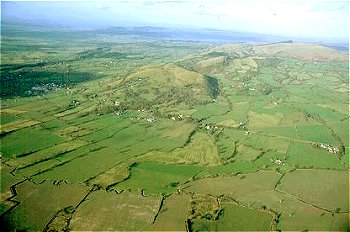
Cymraeg / English

|
Bro Trefldwyn Historic Landscape |

|
Character area map |
Historic Landscape Characterisation
Bro Trefaldwyn:
Todleth
Churchstoke, Powys
(HLCA 1072)
Small and isolated craggy hilltops, important as local landmarks, with later prehistoric defensive enclosures, and post-medieval fields on lower slopes.

Historic background
In the 19th century the area formed part of the townships of Hurdley and Churchstoke in the parish of Churchstoke in Montgomeryshire. The place-name Todleth, first recorded in the early 13th century, may be derived from the Old English tod 'fox' and lith 'slope'.Key historic landscape characteristics
Distinct and small isolated steeply-sloping hills with extensive rock outcrops and screes, between a height of 150-370m above Ordnance Datum, with the higher peak of Roundton to the north and the slightly lower Todleth Hill to the south, much of it now forming part of the Roundton nature reserve. The solid geology is primarily composed of andesite igneous intrusions containing coarse extruded tuffs and lavas within the sequence of Ordovician shales. Loamy, well-drained, brown podzolic soils. Present day land-use is predominantly rough grazing with bracken and gorse and scattered trees and shrubs on lower slopes and some pasture improvement on the lower slopes. Single-species hedges, some overgrown, with post and wire fences and occasional drystone wall field boundaries. In the early 19th century practically the whole of the area was unenclosed common with the exception of a number of isolated and detached encroachments probably of late 18th- to early 19th-century date. Modern boundaries are mostly of post and wire fencing.Footpaths and trackways, running along the contour, between settlements to either side of the hill land. Traces of former barytes mine and trial levels are visible on the southern slopes of Roundton. The steep-sided and craggy summit of Roundton Hill is crowned by a later prehistoric hillfort between 100-160m across, a single rampart set below the top of the hill, 1-2m high and partly using natural rock outcrops, with a single entrance approached by a track leading uphill from the north-east. On the shoulder of the hill between Todleth Hill and Roundton Hill is the smaller defended enclosure known as Castle Ring, again of possible later prehistoric date, on the western edge of the steep-sided valley running down to Hurdley, with traces of a much ploughed down bank and ditch on the southern and western sides. Small-scale 19th-century barytes mining remains on the west side of Roundton, including waste heaps and adits.
Published sources
Charles 1938Ellis 1935
Jenkinson 1997
Toghill 1990
Soil Survey 1983
Spurgeon 1965-66
For further information please contact the Clwyd-Powys Archaeological Trust at this address, or link to the Countryside Council for Wales' web site at www.ccw.gov.uk.
Privacy and cookies